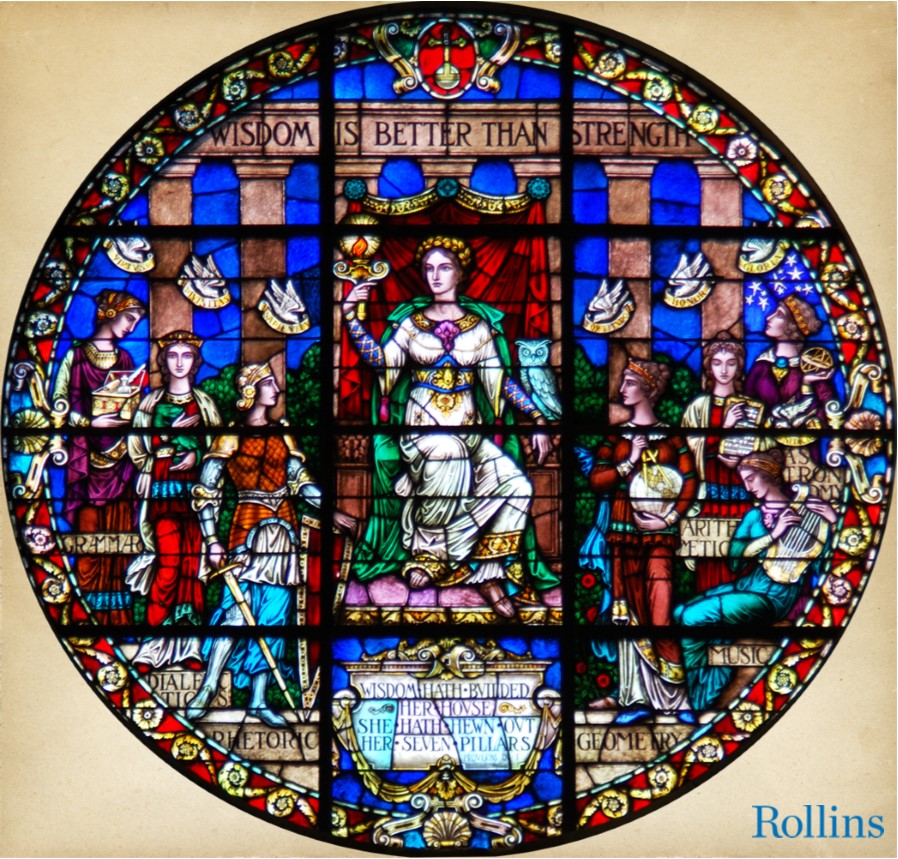
The Rose Window at Knowles Memorial Chapel
By Dr. Jack C. Lane ’08H
Alexander W. Weddell Professor Emeritus of American History and College Historian
Knowles Memorial Chapel, designed by renowned architect Ralph Adams Cram and dedicated in 1932, is justly recognized as one of the nation’s most beautiful college chapels. Whether you are a member of Rollins community or a visitor to the campus, the chapel is well worth a few minutes of exploration. I have a suggestion. When you enter Knowles Memorial Chapel, continue through the vestibule and walk twenty paces into the nave; turn and look high up beyond the balcony. Your eyes fall immediately upon a central feature of the chapel: the stained glass circular window. If it is a sunny day and if you are at all artistically sensitive, you will be astonished, perhaps even reverentially moved, by the light pouring through the multicolored stained glass. Look closer. Unlike traditional geometrically designed circular windows, you will notice the Knowles window is filled with human figures, with lettering and with unusual ornamentation. If you are an inquisitive soul, you may be led to wonder: Why did the artist design this style of window and, beyond its decorative qualities, what do all those figures represent? Be patient. That is the subject of this essay.
Circular stained glass windows (often referred to generically as “rose windows” because many were adorned with rose-like petals) originated with medieval Gothic cathedrals, where they symbolized, through geometric patterns and through brilliant colored light, the spiritual beauty and power of the heavenly vision. As one scholar described them: “[Traditional] rose windows are made of geometric shapes [and] they have a specific number of radiating forms, subdivisions of smaller forms, and sometimes more division in the number of arches and other forms. Every element has a degree of meaning. Whatever the style of window, all of the elements come together in a single cohesive design, the real and symbolic. Think about the importance of specific numbers represented in the Bible. In terms of a symbolic whole, think of the Trinity, or the concept of God the father, God the son, and God the holy spirit as three in one, twelve as a symbol of faith, seven as perfection.” The rose window was a way to make concrete ideas such as these. (1)
Knowles Chapel’s rose window contains all the symbolic qualities of traditional rose windows: seven Liberal Arts, seven doves and seven pillars, and the window divided into twelve sections. It was the content, however, that created a substantive deviation from conventional practice. The window was intended to serve a didactic function for the college community; that is, it provided a permanent visual tutorial on the origins of the liberal arts and symbolically instructed the college on the moral and sacred purposes of a liberal education.
Frances Knowles Warren’s original donation for the chapel did not include enough financing for a rose window, so Cram left a circular space high above the west entrance to be filled when additional funds became available. Mabel Knowles Gage, Frances’s sister, soon came to the rescue, and the rose window was installed in 1934, two years after the dedication of the chapel. The finished product was the result of collaboration between Cram and Wilbur Herbert Burnham, one of the nation’s most renowned stained glass artists.(2) Burnham had been working with stained glass since 1904 and, like Cram, he was a student of the Gothic cathedral and its stained glass windows. Prior to World War I, he traveled extensively in Europe, sketching stained glass windows in several Gothic cathedrals. By the time he returned, he had assimilated and later mastered the unique techniques of their construction. In 1922, he founded the Wilbur H. Burnham Studios of Boston and immediately attracted the attention of America’s leading Neo-Gothic architect Ralph Adams Cram. He crafted his first window for Cram in St. Mary of Redford, a Cram-designed Catholic cathedral in Detroit. More work followed. By 1932, he had become Cram’s favorite stained glass window designer.
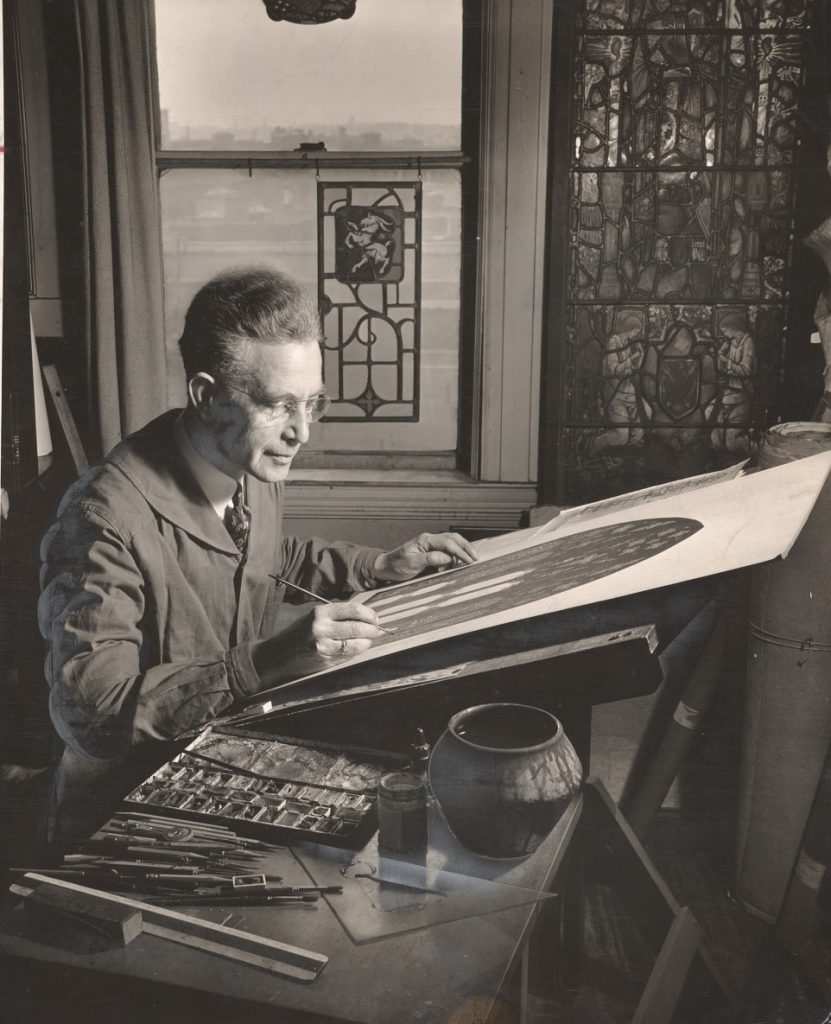
Wilbur H. Burnham at work. (Photo: Paul Davis. Wilbur Herbert Burnham designing a stained glass window, ca. 1940. Wilbur H. Burnham Studios records, circa 1901-1991. Archives of American Art, Smithsonian Institution.)
For the window’s theme Cram selected “Wisdom,” believing it to be the paramount purpose and aspirational outcome of a liberal arts education. Burnham depicted Wisdom as a female figure and placed her at the window’s very center. He described his depiction of her as a regal, “heroic figure holding the lamp of knowledge and with the owl at her left hand.(3) She is crowned with a golden wreath of laurel and is clothed in silvery white enriched with gold and blue.(4) Her over-mantle is in soft, delicate greens, and the figure is silhouetted against a rich ruby curtain which hangs gracefully in folds from three of the pillars.” The Seven Liberal Arts, also represented by female figures, were arranged about Wisdom, “each holding her particular attributes.” The following is Burnham’s explanation of the Trivium figures:
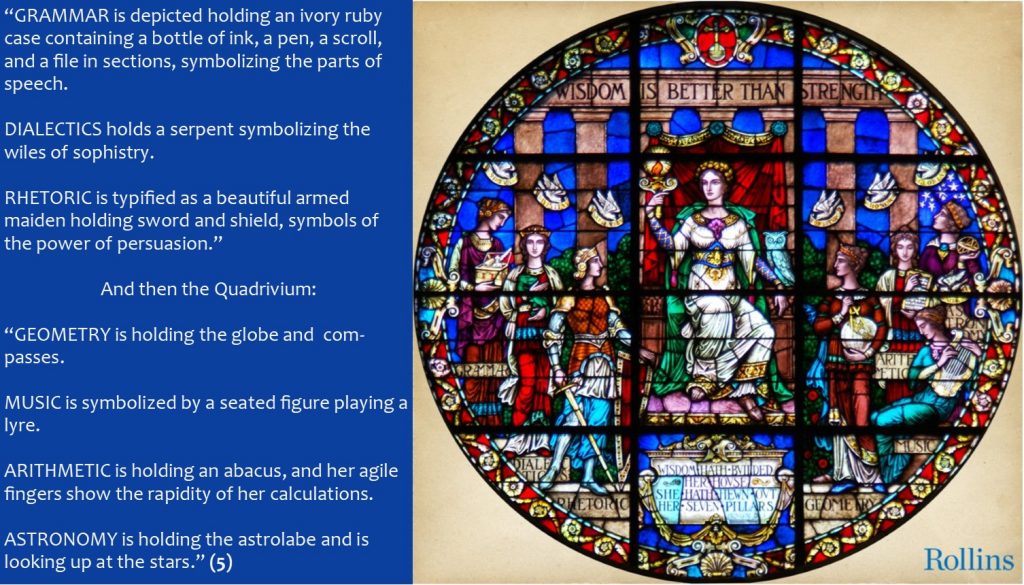
The “general character” of the symbolic figures, Burnham explained, was “designed to conform to the architecture of the Chapel.” The design and figures were “strictly Renaissance, with the use of considerable quantity of white and gold interspersed with rich colors. The conventionalized acanthus leaf is used as a motif for the rich border of rubies and golds. (6)
After absorbing this extended explanation of the rose window’s design, the reader may be excused for wondering: What do all these secular symbolic representations have to do with a chapel designed for religious services? Wait! There’s more. Although less obvious to the viewer, the rose window does contain an important religious component. Hovering above Wisdom are seven doves and behind Wisdom are seven pillars, both representing the Seven Gifts of the Holy Spirit. These “Gifts” were an early Christian set of beliefs taken from the Book of Isaiah 11:1-2 and later adopted by the early Christian Church. The gifts included wisdom, understanding, counsel, fortitude, knowledge, piety, and fear of the Lord. As explained by St. Augustine (who incidentally occupies the northern stained glass window in the chapel’s apse):
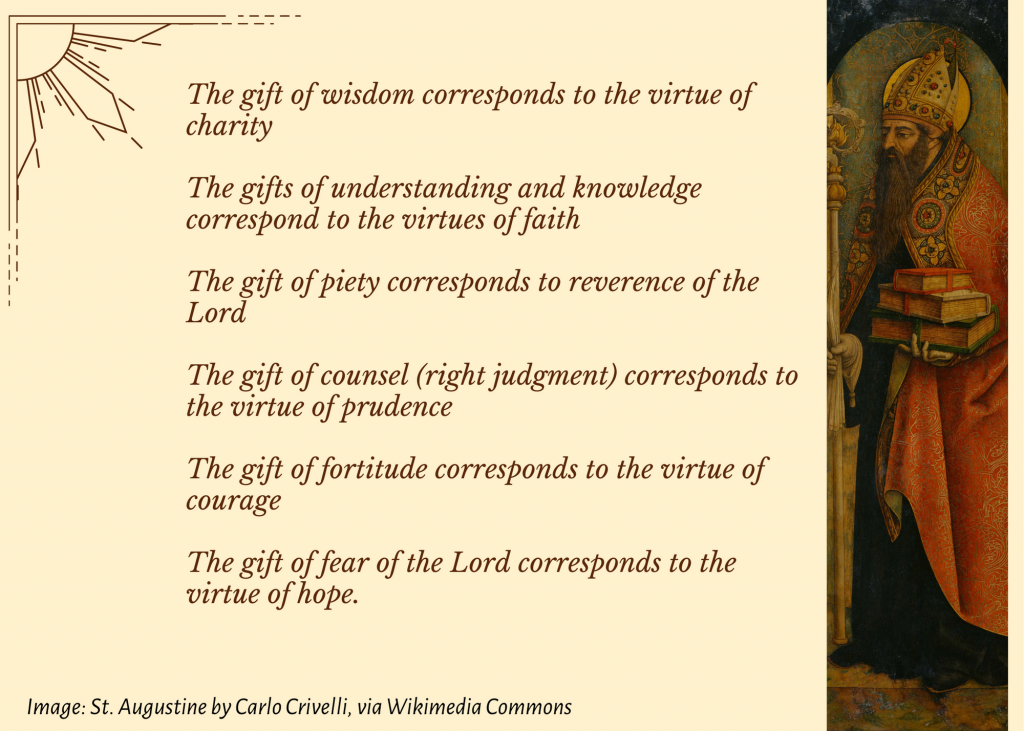
On the lintel above Wisdom appears the text: “Wisdom is better than strength,” from Ecclesiastes 9:16, and at her feet is the text: “Wisdom hath builded her house, she hath hewn out her seven pillars” (Proverbs 9:1).
These Biblical texts and the Seven Gifts of the Holy Spirit were, of course, appropriate for a Christian chapel, but they actually were intended for an even a larger purpose. Cram believed deeply that religious instruction was an essential element in a liberal education. A college education, he once declared, “should develop all the intellectual and spiritual qualities of young people” and the most effective way to achieve the latter, he argued, was immersion in religion. It was a “damnable opinion,” he contended, “that education [and the inculcation of ethics] may be divorced from religion. We have pretty much learned by this time (1914) that there is no effective education that is not interpenetrated by religion at every point.” (7) In Burnham’s words, the Seven Gifts, symbolized by doves and pillars, “signified the sanctification of the Liberal Arts by spiritual force.”
Thus, for Cram, the rose window played an essential role in the larger meaning of Knowles Memorial Chapel. The beautifully designed chapel was mainly a venue for religious services, but, just as importantly, in an age of growing secularism, it served also to emphasize the centrality of religion at Rollins College. The rose window with its Seven Liberal Arts and its Seven Gifts of the Holy Spirit functioned symbolically to tie the chapel’s religious purpose to the college’s academic life. The rose window was intended to stand as a constant visual reminder of the liberal arts-cum-religious roots of the college’s traditional liberal education mission.

Ralph Adams Cram ’38H, the architect of Knowles Memorial Chapel
At the dedication of the window, Hamilton Holt, in his customary poetic style, captured the beauty of the rose window and revealed its meaning to the chapel and the college community: “The rose window, gathering the rays of the Southern sun, is like a luminous jewel upon the breast of this beautiful body of the chapel. It is appropriate in a college that the dominant, central theme of Wisdom be identified with both education and religion.” For Hamilton Holt (and Ralph Adams Cram), the rose window united the sacred and the secular, faith and reason, the liberal arts and divine wisdom. It signified a visual symbolic fusion of a liberal arts education and the Christian religion.
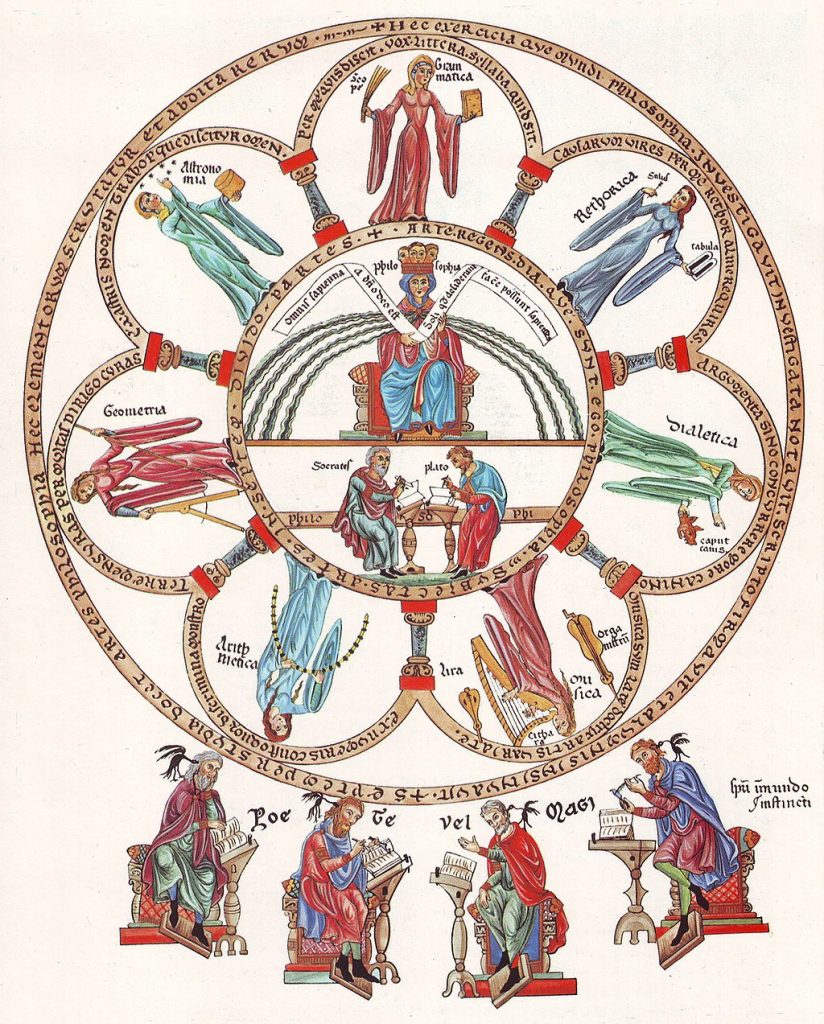
The Seven Liberal Arts (Image: Herrad of Landsberg, via Wikimedia Commons)
ENDNOTES
1. See Charles J. Connick, “The Great West Window of the Cathedral of St. John the Divine.” Perhaps the most elaborate depiction of the Seven Liberal Arts is found on the tympanum of the west door of the Chartres Cathedral. See Burckhardt, “The Seven Liberal Arts and the West Door of Chartres Cathedral.” Studies in Comparative Religion, Vol. 3 (1969).
2. I could find very little written material on Burnham’s life and career, but I did discover a summary of a 1935 article he wrote for the Stained Glass Quarterly. In the article, Burnham “expresses his views about the importance of the medieval tradition in the harmony of the primary colors, red, blue, and yellow, with the complementary orange, green, and violet typical of his windows. His studies of medieval windows demonstrated that reds and blues should predominate and be in good balance. Burnham also noted that windows should maintain high luminosity under all light conditions. Some of the studio’s most notable commissions included seventeen windows for the Washington National Cathedral in Washington, D. C., all the windows and murals for Saint Mary’s Cathedral, Peoria, Illinois, ten windows for the Cathedral of Saint John the Divine in New York City, and five for the Riverside Church, also in New York City.”
3. The lamp of wisdom fits nicely with Rollins’s motto: FIAT LUX. Traditionally the owl has been a symbol of knowledge, wisdom and erudition.
4. According to Greek mythology, the laurel wreath symbolized triumph. White is often associated with purity and goodness.
5. The astrolabe was an early instrument used by astronomers and navigators to determine latitude on land and calm seas.
6. In Mediterranean countries, the acanthus leaf represents immortality.
7. Ralph Adams Cram, The Ministry of Art (1914), 170.
